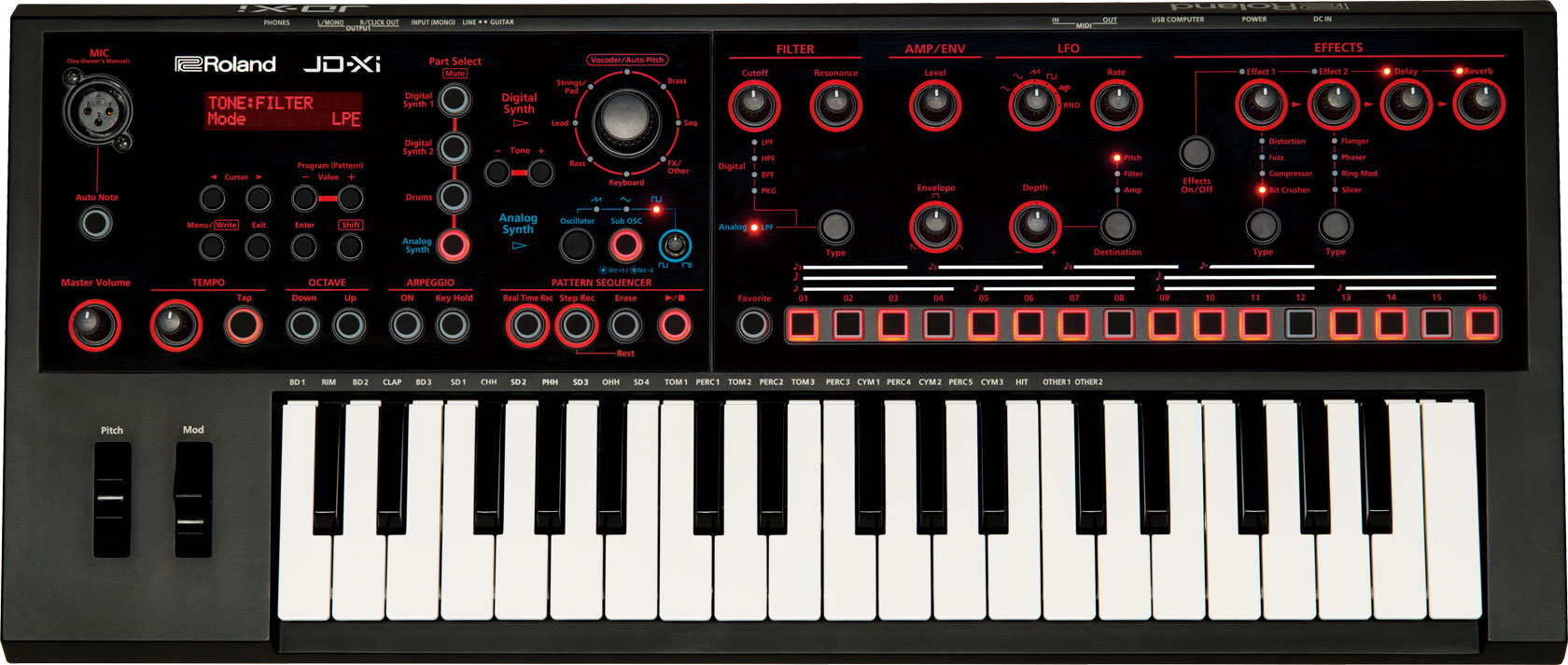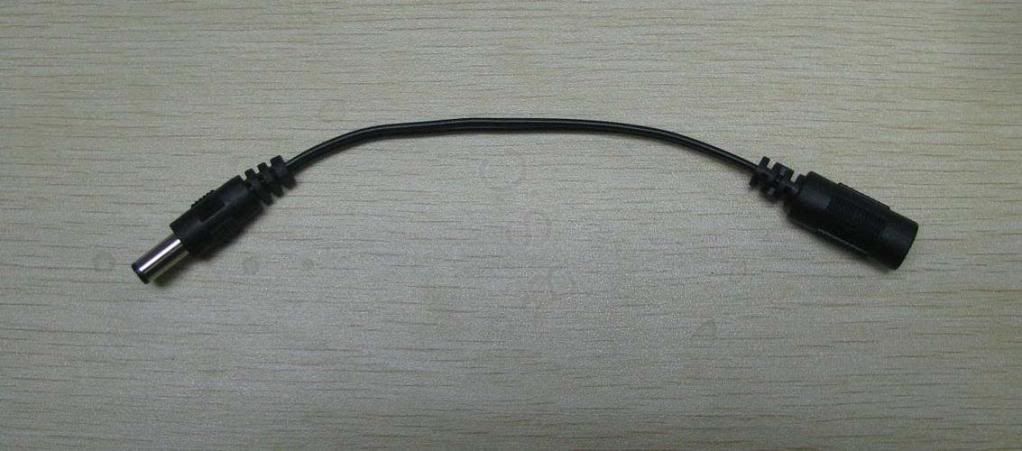Intro
Before Christmas I bought myself a gift, namely a Roland JD-Xi synthesizer. It looks like this:
It is my first real synthesizer (I've got some simpler keyboards before) and it's really nice.
The Problem
There is one thing that annoys be however and it is the fact that you cannot power it by batteries (I tend to want to use it in different rooms in our apartment, and I have to carry along the AC adapter all the time). The guy at the store tried to explain to me that this was indeed a real synth ("it's not a toy", kind of thing) and those did not get to be powered by batteries, No Sir. Turns out that there are several smaller synths that can be powered by batteries as well as an AC adapter. Oh well...
A solution?
At Christmas, I got this "USB-battery" (known also as a "powerbank" and many other names):
Looking at the specs of the battery I realized it was very close to what the JD-Xi needed. The AC adapter for the synth delivers around 5.8 V and the manual says the synth uses at most 1000 mA (1 A) of current. The battery spec says it can deliver that, for 5 V (which means the current will be a bit higher since the voltage is lower). I discussed this with a couple of electronically savvy friends and decided I would try and make myself a cable that would take the power from the USB A socket in the battery and "convert" (well...) that to the needed DC plug.
But let's back up a bit... First I thought I should buy one of these things. I searched eBay and found that there is indeed a cable that does almost what I want:
The "only" problem with it is that the poles are wrong on the DC plug side. The adapter from Roland has the + on the outside and - on the inside, but these thingies has it the other way around as you can see above (you can see it at the top of the insert in the image). Since I do not want to fry my new and shiny synth I had to find another solution. So, I found this polarity changer:
Nice!
Now... I could order this from eBay and wait the four weeks it takes for the stuff to arrive to Sweden, or... I could make my own cable! (with no need for the extra polarity changer/switcher). And this is exactly what I did today. By the way, if *you*, on the other hand, are happy with that solution, or even happen to find a USB-cable with the right polarity, perhaps you don't need to continue reading :) For others, read on below...
What you will need
Male DC plug 5.5 x 2.1 mm
On eBay I could not find any auction for buying only one but probably your local electronics store will sell you one like these:
Now, be careful here! It should be 5.5 x 2.1 mm, NOT 5.5 x 2.5. OK? For some reason, and probably because manufacturers want to lock us in to buy their adapters, there is a gazillion (well...) different plug sizes and with different polarities. Make sure you get the correct one.
An old USB cable with at least one USB type A male plug (that we will maim)
Well, it does not have to be old of course, you can buy a new (cheap) one, You could also buy only the male USB A plug and solder a cable onto that, but I found it more convenient to use an existing one. That way, I only needed to solder the cable in one of the ends.
The USB type A male plug is this quite big and flat USB plug that we all know and love:
The pins in this plug are defined like this:
As you can see above, the power is on pin 1 and 4. 2 and 3 carry the signals.
Soldering iron, pliers and a voltage meter
I will not describe for you how to solder, how to cut wires etc. If you don't know this probably you should buy the stuff from eBay I mentioned above :) I have included some "safety" tips below though, for critical steps.
What to do
First, cut the USB cable to a length that suits you. Think about how you will use it, if you want to keep the battery at the side of the synth or attach it to it in some way (adhesive velcro strips should work nicely for a very mobile approach).
Carefully strip the outer shell of the end of the cable that you just cut, to reveal the four inner wires/cores of the cable.
Now you need to strip the inner wires as well. If you are lucky like I was, they are correctly colored (red for +5 V, black for ground/-). To be sure you should check the voltage of the wires to find the two ones that delivers the current (the other two are signal wires). So, if you have a black and red one, strip those first and use the volt meter to check if they are the correct ones (it should say there is around 5 or -5 V, depending on how you measure it), when the plug is inserted into your USB-battery. Make sure none of the small stripped wires touch each other once the plug is inserted in the battery!
When you know what two wires deliver the current you must also know which is + and which is -. I do it like this: normally the volt meter has one red wire for + and a black for -. Make sure the wires are in the correct place in the volt meter. Then, when you get 5 V (not -5) when you measure the voltage of the USB wires, you know the + one is the one that the red volt meter wire is touching. Make a note of which wire it is.
Now that you have identified the two USB wires that carry the power, you need to solder them to the DC plug. Before you solder them, put on the outer "shell" of the plug on the cable first (always irritating to notice this afterwards). Make sure you solder the + wire such that it is connected to the outside of the DC plug and that the - wire is connected to the inside/middle. Also make sure the two wires to not touch. If you have a good volt meter you can either use the beep function, if it has one, or use the resistance/Ohm metering to make sure there is no connection between the plus and minus wires (when the cable is not connected in either end).
I tried to take a photo of my plug:
Here is the final cable:
Now, before you try it out, try to measure that there is indeed a connection between pin 1 and 4 and the inner and outer part of the plug, and that there is no connection where it should not be. When you have tried this, you can input the USB plug into your battery. If nothing smells bad or blows up, probably you did it right :) Now measure with your volt meter if there is 5 V between the inner and outer part of the DC plug. If it is, it is time to try it in the synth - yay!
For me, it looked like this, this evening:
Just above the synth you can see my USB-battery happily powering along - hurray! :)
Trivia
Before I actually built the final cable I did a lot of measuring of how much current the synth use when powered by the AC adapter. The specs says it should use 1000 mA but it turns out that I could not get it to use more than 0.7 A / 700 mA (for me, it used 0.64 A when turned on and idle and went up to 0.66 A for most of the included demo programs). This means we are probably quite safe since the USB-battery specs say it can deliver 1 A / 1000 mA (since the voltage is lower it HAS to be able to deliver more than 700 mA). When I measured I only had headphones attached to the synth.
The actual voltage of my AC adapter is 5.8 V.
Disclaimer
Since I'm no electronics expert I don't know how this solution will work in the long term, so I cannot make any promises of how stable and safe this hack is. But I feel it should be quite safe.
Update 2016-01-06
After trying the small battery out for two days it looks like I get around 2 hours of play using the small 2200 mAh battery. Quite okay in my view. You can buy bigger ones with 5000, 10000 or even 50000 mAh if you need. There are even solar powered ones if you want to be totally off the grid :)
Update 2016-01-17
Been using this hack for some weeks now and it works great. Today I even filed away the AC adapter, to be forgotten in a drawer... :) I also did something I planned from the beginning and attached the battery on the back using some Velcro tape:
Quite neat, and very portable. Being as small as it is, the synth is now very easy to move around the apartment. I just need to have a pair of headphones with me. I can remove the battery and charge it or I can simply plug in a normal micro USB charger to the battery where the synth happens to be right now. To conclude this update I'm very happy with this simple hack and I really feel that the lack of battery operation is not a problem anymore.
Update 2018-03-10
So, for those who has not read the comments below, I want to highlight here that this hack has some problems powering the JD-Xi when playing some analog tones. See comment below for more details.
Update 2020-07-07
For the benefits of others I want to share another solution that I found:
http://myvolts.com/product/46110/Power_Supply_and_Chargers/Ripcord_USB_to_5.7V_DC_power_cable_compatible_with_the_Roland_JD-Xi_Synth
If that works, it should be an almost ideal solution. I have tried doing my own such "cable" using both step up (boost) and step down (buck) converters, but I have not had much luck. I think the quality of the converters I have got hold of is not the best as the amount of current increases. In theory it should work though and I hope the makers of the cable I linked to above have made their homework and have a solution that works.
So, yeah...
Also see the discussion here:










